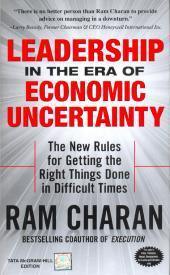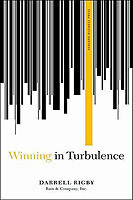Raj Shankar's Blog, page 62
January 18, 2013
Books and Me: Leadership In The Era of Economic Uncertainty
Title: Leadership in the era of Economic Uncertainty 
Author: Ram Charan
Ram Charan is a much sought after consultant. His books are interesting, practical and highly applicable almost instantaneously. As a regular reader of his books, I decided to pick this title as part of a research I have initiated on ‘managing in turbulent times’. The book is typical Ram Charan. After the first few pages of high level inputs on the nature of turbulence in the business world, he dives straight into what each one in the organization must contribute so that the organization can survive and thrive in rough weather.
Normally when I read a book, I mark up things that trigger some thoughts for contemplation and write down stuff that I can share with my consulting clients. With respect to Ram Charan’s book, there are scribbles, underlines and notes all along the margins. As to my notebook, there are just many things that are straight and to the point for application in most businesses. My favorite chapter is the first one “The challenge of managing in a toxic environment”.
The intent of the ideas are as much applicable to organizations of every size. I have been recommending this to my client CEO’s, insisting they read not just the chapters aimed at them but look at the other chapters aimed at innovation, finance and human resources as well. Since most of my consulting and training services are to mid-sized enterprises in Asia Pacific region, I ask them to look up the whole book – as it is common here for senior personnel to oversee more than one function. Though the concepts seem straight, some amount of customization of the views presented could be required before applying to their business.
Though the book is much shorter than what it seems by its layout, it is quite an intense read. The book is aimed at leaders who have to steer the organization through the recession. The author’s experience of working with large corporations is reflective in the chapters. With some customization of the ideas, they seem useful to small and medium enterprises as well.


January 17, 2013
On Entrepreneurship: All Ventures Are Social Ventures
In a recent classroom lecture with my students we were onto discussing the categories of enterprises and their  challenges. A lot of discussion happened around what are the characteristics of social enterprise and what mindset is required to start and run a successful social venture. Socially inclined cause, focus hinged on impact of operations, highly efficient resource utilization and ability to constantly put beneficiaries ahead in every action emerged as strong characteristics.
challenges. A lot of discussion happened around what are the characteristics of social enterprise and what mindset is required to start and run a successful social venture. Socially inclined cause, focus hinged on impact of operations, highly efficient resource utilization and ability to constantly put beneficiaries ahead in every action emerged as strong characteristics.
Suddenly someone raised the question on why these become secondary for any other venture type. Aren’t these fundamental to any business? Then, the debate on factors differentiating a social venture from any other picked up. Much of the arguments were around the cause and the motivation that drives various types of organizations. The class agreed to settle this by declaring as an entrepreneur if you are set to making a difference to the larger society than yourself – you are running a social venture. If the motivation to create an enterprise is to make a difference to yourself then the enterprise moves into the for-profit category.
But we also agreed that a good for-profit can be only created, if it creates value for others. Only if you make products and services that makes a difference to your customer’s life at affordable prices – do you have a good for-profit running. So even at the heart of a for-profit organization should be the value that gets created for the customer in the most optimal manner. Making those useful products / services at affordable prices that will make life better for the thousands who can pay for it is the social consciousness that has to be ingrained in the DNA of any venture. Every successful business running a for-profit had made it big only because of this social consciousness of creating value. When you recognize and work with the understanding of the social side of your venture, the returns you get becomes multi-fold!


January 16, 2013
On Innovation: Where Is Your Focus?
Innovations are needed not just in products and services. They are more importantly needed in looking at markets differently, going to market differently, for better relationship orientation and also around the business model.
the business model.
However many corporate obsessively focus innovation efforts and outcome only on product design and new product development. While these seem as obvious areas which would reap benefits, one cannot ignore the benefits of innovation in area of process, service, sales etc. Where we have seen maximum benefit is when we ask the teams we train to think on their own work process and outcome, and ask them what is it they want to change in the current practices as both performers and beneficiaries.
We constantly tell our clients that innovation does not mean coming up with one great new idea. It is coming up with useful small shifts in routine, small experiments which could possibly move productivity, throughput, resource utilization by many notch higher. By encouraging the employees to perceive innovation as that little thought that could make their work life easier and better, more benefits have been reaped than when innovation is seen as that epiphanic moment of path breaking idea.
Every time we get a chance to re-orient the strategic innovation ability of an organization, we realize the true potential of an institution. Unleashing the innovative abilities of people results in tremendous energy within the institution and thereby resulting in improved performance (internal and external).
So where is your focus: Narrowly focused on products or broadly at the level of organizational process and dynamics? Focused on that one big strike or on many small experiments?


January 15, 2013
Unconference on Business Modeling (20-Jan-2013) at Tata First Dot 2013
National Entrepreneurship Network (NEN) is hosting the 3rd edition of the Student Startup Event ‘Tata First Dot’.  We (‘ichiban Consultants’) have been invited to facilitate the unconference on Business Modeling between 2:00 PM and 3:30 PM on 20th Jan’13. The venue is IIT Madras.
We (‘ichiban Consultants’) have been invited to facilitate the unconference on Business Modeling between 2:00 PM and 3:30 PM on 20th Jan’13. The venue is IIT Madras.
For those who are new to ‘unconferences’ – here is a short introduction to it. Link: http://en.wikipedia.org/wiki/Unconference
We have decided to experiment something this year! Why not crowdsource ideas for the session?
If you are attending the Tata First Dot event/ If you are one who is attending the unconference session on business modeling at Tata First Dot / If you are one who has benefitted from the concept of business modeling / If you are intrigued by concept of business modeling and design:
THEN we request you to send in your suggestions for what are the aspects that should get discussed in the session.
Please feel free to share your thoughts / suggestions / queries / ideas in any of the following methods:
- write a comment on this post
- send an email to rajshank@gmail.com
Since we need to plan the session, we will take all inputs that reach us before 9:00 AM on 19th Jan’13.
Hope to catch up with you at the event!


Vedantic Wednesday: Feeling Emotions and Being Emotional
Last week’s blog on being indifferent under the guise of being detached (http://rajshankar.wordpress.com/2013/01/09/vedantic-wednesday-detachment-not-indifference/) led to a lot of conversations  with few of you. While the discussions themselves were a mixed bag, it did bring out that few of us were doing some serious introspection. This week I want to place in front for your consideration my humble understanding on a similar area of misunderstanding – feeling emotions and emotional.
with few of you. While the discussions themselves were a mixed bag, it did bring out that few of us were doing some serious introspection. This week I want to place in front for your consideration my humble understanding on a similar area of misunderstanding – feeling emotions and emotional.
Typically we see ourselves reacting to situations. Then on analysis we remark, ‘ I should stop being so emotional’. What does this mean? To many of us it means not feeling the emotions at all. We assume a great sage is one who does not feel any emotions of sadness, happiness, anger, pain etc. So without much further investigation we begin to control our emotions. We adopt practices of controlling our natural feelings that arise at any situation. This is a process of systematically numbing ourselves to feelings.
Numbing of feelings at physical and mental plane is not the method to exhibit self-control. It is akin to rote-learning vs understanding. It can take you only that far in life and journey of realization. In simple words (at the cost of technical transgression) we can understand becoming emotional to indicate falling a victim to the after-effects of feeling an emotion. You get angry. That is an emotion; but what do you do about it? Throw tantrums? Or understand that not everything has to happen as per your plan and look at what needs to be done? Somebody steals your wallet. You feel sad about having lost a sizable sum. What do you do about it? Grieve and curse ? Or figure out what vulnerability in your behaviour was exploited and how to ensure you cover it up going forward?
One cannot at the initial level control feeling these different emotions. But one can control the actions that get triggered on experience of emotions. This is the difference that we need to understand. For a person who has realized life in its true essence, everything that life dishes out is a Prasad. A blessing; an opportunity. So the only emotion that runs through him at every instance is happiness, peace and bliss. Through deeper understanding of life, he has only emotions of bliss and gratitude in him.
However, till the time we reach that stage, we have to take smaller steps everyday to control how we react when we feel an emotion. We should not be controlling the feeling that arises in us. We should not become inert. We should become more aware - of ourselves and our impact on others!


January 14, 2013
On Strategy: Where is it?
Every business leader and entrepreneur think they have a well thought of strategy. They think they have it all chalked out. They can talk about it all the time and recall it at any moment. But when you ask them to  make a presentation to an audience formally – most falter! Not because they don’t know their business, but because they have not written it down. When a business is small, one can keep all of these things in the head. But as the business grows, the entrepreneur / leader must understand the importance of having a written strategy document.
make a presentation to an audience formally – most falter! Not because they don’t know their business, but because they have not written it down. When a business is small, one can keep all of these things in the head. But as the business grows, the entrepreneur / leader must understand the importance of having a written strategy document.
What must a strategy document contain? In MHO a strategy document must contain:
Purpose of the Firm
Values (what we will and won’t do)
Choices (Products/Services/Markets/ etc)
12 month Goals
36 month Goals
The 12 month plan
Most small business owners in their attempt to grow, end up trying to be more active than before. They get aggressive and continue their early habits of enterprise growth. They do now what they have been doing all the while, with greater vigour. But this may not really help, if where they want to reach is another point in the growth chart.
As the organization grow to become more than just the owner and his intentions – written documents help everyone associated (including the owner) understand their changing roles, contribution and context. A written document provides great clarity on the ‘What’ and thereof on the ‘How’ of the journey. This enables decisions that are effective, prioritization that is consistent and purpose that is common.
A formal presentation to the team energizes the team, aligns them and indicates to them what is expected of them. This sets the tone for further meaningful action from each and every individual of the team. As a start, this integrates best the intent with the expected action. Most of the time during my review sessions on strategy with CEOs of emerging companies, I enable and catalyze this exercise. I work with the CEO in getting his team charged up and get actions off the ground. If the leader does not do this – no amount of motivation programs can help, especially at the senior levels. If you haven’t done it yet – do it now! Call me if you need help!!


January 13, 2013
On Leadership: Clarion Call For Clarity
One of the first things which demarcate successful leaders from others is their clarity. Clarity is not just the ability to clearly think through situations. It is to understand the intention of the company, its purpose, its goals, its  culture, its strategy, its people and amongst other things, themselves. When a leader clearly understands each of these, they becomes light, free, aggressive and action oriented. What stops execution most of the time is not lack of energy, but dissipation of it due to confusion. When senior leaders in a firm are confused because of changing signals from the external environment, it makes the situation worse for others associated with the firm.
culture, its strategy, its people and amongst other things, themselves. When a leader clearly understands each of these, they becomes light, free, aggressive and action oriented. What stops execution most of the time is not lack of energy, but dissipation of it due to confusion. When senior leaders in a firm are confused because of changing signals from the external environment, it makes the situation worse for others associated with the firm.
Successful leaders need to be sure about what they want to achieve and not keep changing them too often. The ‘how’ may need to change often especially in today’s turbulent world. But a changing ‘what’ – just confuses all who deal with the leader and the firm. Employees, vendors and even customers become confused. They see changing signals – leading them to distrust the firm and the individual.
If you want to keep you staff together, keep them energized, keep them action oriented – first develop the clarity for yourself. With clarity comes conviction and energy to persist. When people see a person with clarity and conviction – they automatically tend to follow.
So begin now and seek clarity! That is what is needed today, interestingly at all levels of leadership!


January 12, 2013
Interesting Links This Week: 13-Jan-2013
It is just the second week of the new year. So I could not help running into reads on goal setting, targets, strategy etc. Here are those that stayed with me after I had read them. Hope you will like it.
Still not too late to learn how we can define goals for 2013 http://bit.ly/UIYumi
But then I equally liked this one that urges us to not get caught with constraints of goals; but indulge in dreaming http://bit.ly/UgtLgb
Very interesting read on how Drucker thoughts is helping a small business owner run his firm http://bit.ly/U33z59


January 11, 2013
Books and Me: Winning in Turbulence
Title: Winning in Turbulence
Author: Darrell Rigby
This book is not what it looks like! Don’t get carried away by its appearance. You will realize as soon as you get into the book, within a few pages that it’s definitely not a casual reading. It contains some of the best thoughts on ‘Managing in Turbulent Times’ in concise form. It lives up to the series that it belongs to – ‘Memo to the CEO’. 
Every CEO / Entrepreneur / Small Business Owner should read the book. It has enough tips, tricks, techniques that can enable you sustain, survive and thrive during a rough patch. Considering that rough patches have become more frequent and more turbulent – such books are a useful addition to the leader’s bookshelf.
The book being in its concise form leaves a lot to be read further, if a leader wants to use any of the important ideas. Since it comes from Bain and Company, almost all the references also lead to their other works. Right from concepts on the core and adjacencies to Net Promoter Score – all of which are concepts, tools, and frameworks of Bain, they lead you inherently to further books and reading based on research at Bain. There is no doubt that each of them are wonderful books and extremely useful concepts and frameworks. This little book at times seems like a curtain raiser to the Bain concepts at large. The book infact matches your challenge to the right tool and book for your further consideration.
I enjoyed reading the book a lot. Being a strategy researcher and consultant, I take away a lot of interesting inputs and triggers for further thinking. Overall a book that will remain relevant for days to come!


January 10, 2013
Is Your Small Business Responsible Enough?
Every institution needs to be self-sufficient, else it will require external life support. In cases where external support is not available in time – the institution invariably faces closure. In recent times we have seen so many for-profit firms in the United States and around the world being given life support by the governments. Why was it done? It was primarily done to reduce the social impact of a possible fall out of their closure. Why only for the big firms and not the thousands of small firms? Because the impact of thousands losing jobs in a society is much higher than a few. From a government stand point, though there should not be a difference – the priorities are clear. Larger good is always to be taken care of first. So when it comes to life support for larger companies, the government and at times the business ecosystem itself gears into a crisis saving action. What choice do smaller organizations have?
fall out of their closure. Why only for the big firms and not the thousands of small firms? Because the impact of thousands losing jobs in a society is much higher than a few. From a government stand point, though there should not be a difference – the priorities are clear. Larger good is always to be taken care of first. So when it comes to life support for larger companies, the government and at times the business ecosystem itself gears into a crisis saving action. What choice do smaller organizations have?
There are two choices. They can make noise, knock for help, lobby and wait as other rightful priorities get addressed. Or understand that when they are small, they need to operate with heightened responsibility – as external help may not be too forthcoming. When an organization however small closes, it has an immediate impact in the social and economic context of its employees, suppliers and customers. It is best that leaders of the small businesses realise this, put efforts in running a sustainable outfit from day one, be sensitive to early warning indicators, become agile to respond, be fearless to experiment – but be courageous and practical to accept harsh realities and work guided by that realization.
Simply waiting for external help or miracle to happen cannot be a bailing strategy for any company – especially the smaller ones. When we understand, that it is these millions of smaller companies, that make the majority of the socio-economic fabric of our country, the collective social responsibility of these firms become highlighted. Heads of small business units need to understand that they have a wider role to play than running their set-up for immediate profits. Sustainability of operations should be the first responsibility and focus of a business – more so in case of smaller set-ups!





